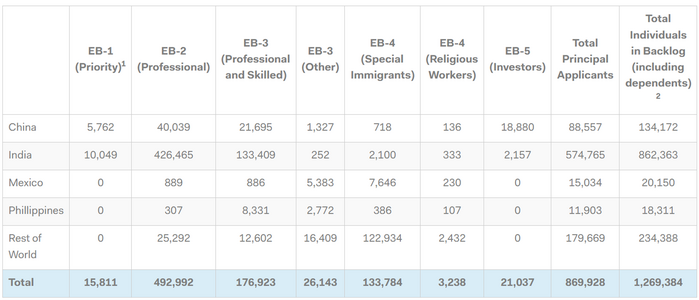Four Main Paths of Immigration
A lot of discussion about immigration eventually gets to the assertion that immigrants should “just get in line and come the right way.” But what line? And how long is that line? Is there even a line that they can join? While there are lesser used avenues to immigrate (such as being an “exceptional person” like an Olympic athlete), the INA designates four main pathways of immigration. These pathways can be remembered by the pneumonic of Blood, Sweat, Tears, and Luck
Family Based- Migration (Blood) –
The largest number of immigrants come through family-based immigration – being a blood relative. This avenue is only for immediate family members of US citizens and Legal Permanent Residents (those with a Green Card). Immediate family is defined only as parents, spouse, siblings, and children. Grandparents, cousins, etc. do not count as immediate family; neither do parents of Green Card holders. Family-Based immigration is split into two categories:
- Spouses, parents, and unmarried children under 21 years old of US citizens
- There are no true caps on the annual number of entrants in this category, but processing wait time limits the number of entries each year.
- Depending on backlogs (and backlogs differ based on relationship to the citizen who applies and the country of origin), processing time for this category is currently somewhere between 14-50 months
- Spouses and unmarried children under 21 of LPR and adult children and siblings of US citizens
- This category is subject to total limits as well as country-based limits
- No more than 480,000 people in this category total may enter the country in total each year
- No more than 7% of all immigrants may come from the same country
- For example, if you are the Mexican sibling of a US citizen, USCIS is now processing applications from August 2000.
- If you are the Vietnamese cousin of an US citizen who isn’t eligible for some sort of humanitarian entrance, there is no path to immigrate to the US at all.
Employment-Based Immigration (Sweat)
Employment visas as divided between permanent visas and temporary visas. There is a cap of 140,000 permanent visas each year (plus any unused family migration visas). There is no cap on temporary work visas.
For employment-based immigration, the visa has to be sponsored and paid for by an employer. To be eligible, the employer must show evidence that the visa recipient is labor certified (
labor certification establishes there are insufficient U.S. workers able, willing, qualified, and available to fill the position and this employment of this individual will not adversely affect the wages and working conditions of similarly employed U.S. workers) and meets the criteria of the priority category applied for:
- Priority 1: Priority Worker and Persons of Extraordinary Ability: Have received medals/awards in the sciences, arts, education, business, or athletics; internationally recognized researchers; managers/executives of a US company overseas
- Priority 2: Professionals Holding Advanced Degrees and Persons of Exceptional Ability: their expertise is above that normally encountered in their field
- Priority 3: Skilled and professional works and unskilled workers with 2 years of training
- Priority 4: Certain Special immigrants: Amerasians, religious workers, broadcasters, former employee of the US government
- Priority 5: Immigrant Investors in new commercial enterprises that lead to job creation
While on their visa, their presence in the US is tied to their employment by the petitioning company. They can work for another company once they become a Legal Permanent Resident. However, there is a huge backlog in Employment based Green Card processing – this leaves immigrants without the ability to seek better employment and often leads to stagnant wages. Without the Green Card, spouses and children are not able to work. Backlogs are based upon annual limits and country caps. For an Indian worker who applies today, the estimated wait due to backlog is about 54 years.
EB Green Card Backlog (as of 1/31/24):
 Humanitarian Immigration (Tears)
Humanitarian Immigration (Tears)
This will be covered more in depth below, but these avenues are through the US Refugee Admittance Program, Receiving Asylum, being granted Temporary Protected Status, or Humanitarian Parole
- TPS - Temporary protected status (TPS) is a program that allows migrants whose home countries are considered unsafe the right to live and work in the United States for a temporary, but extendable, period of time. Though they are not considered lawful permanent residents or U.S. citizens, many have lived in the United States for more than twenty years.
- Humanitarian Parole - Humanitarian Parole is granted to a foreign national who is otherwise inadmissible to temporarily enter the United States due to an emergency and urgent humanitarian reason or significant public benefit.
The Diversity Visa Lottery (Luck)
For those that do not meet the above criteria, they may try to immigrate through the diversity visa lottery if eligible. This avenue is only open to immigrants from countries that have had fewer than 50,000 entrants total in the previous 5 years and have the equivalent of a high school degree or at least two years of employment in the last 5 years in certain labor fields. (Currently ineligible countries: Bangladesh, Brazil, Canada, The People's Republic of China, Colombia, Dominican Republic, El Salvador, Haiti, Honduras, India, Jamaica, Mexico, Nigeria, Pakistan, Philippines, Republic of Korea (South Korea), Venezuela, and Vietnam).
Generally between 10-20 million people apply for the 50,000 spots (so .25%-.5% accepted)
These are the “lines” available to people try to enter the country per the current INA. For many people, there are no lines. For others, the line might be over 20 years long.

